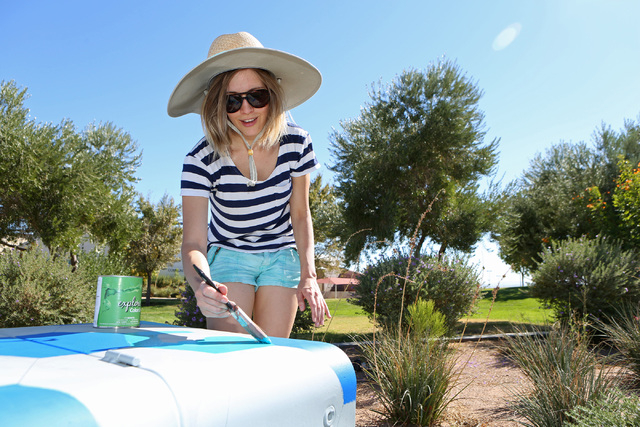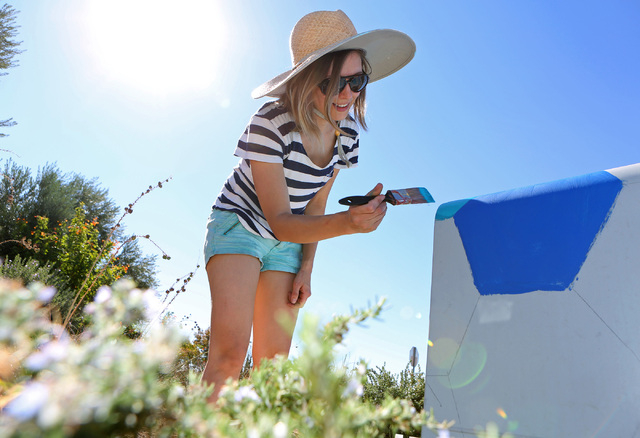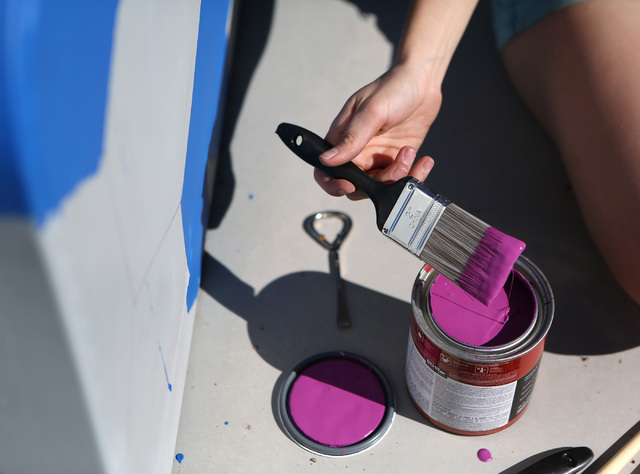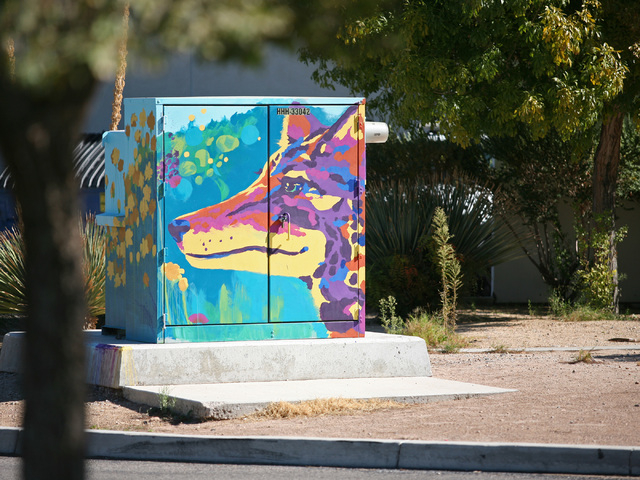Beautifying by brushstroke: Artists paint utility boxes near Desert Breeze
Not all art is found in museums.
The Zap! Project, which was created as part of the Las Vegas Centennial celebration, brings public art into the suburbs. The newest effort, Zap 5, is in the area of the Desert Breeze Community Center, 8275 Spring Mountain Road, and utilizes utility boxes. They have been taken from a drab gray to sport colorful renderings by local artists.
Native Las Vegan Tatiana Hantig earned her fine arts degree from UNLV and was tapped to paint five boxes on the Desert Breeze property. She joked that she got an early start on decorating such common structures as there was one near her parents’ home. As a child, she took the opportunity to put her mark on it, a sort of “Tatiana was here” kind of doodle, she said.
“No one ever came around and took it off,” she added.
Hantig’s renderings are done in bold, bright colors and combine a wrap technique with actual paint. One of her assigned boxes is up against a bush. That side received a chevron (V-shaped) design. The three sides that people can see are more involved.
“Mine is a colorful rendition of different plant life and animals that I’ve seen in Las Vegas,” she said. “I’ve seen coyotes here, jackrabbits here, and I also wanted to explore some of the floral side of the city. People who move here tend to think it’s very lifeless here in the desert, but I think that it’s full of life, like the marigold flowers and the globemallow flowers. I think those are my favorites. I wanted to introduce that there is a lot of life in the desert if you look for it.”
Hantig dismisses the color black and is instead drawn to bright pastels and mixing colors in interesting ways. Her coyote, for example, is rendered in magenta, yellows, blues and purples.
“I think all of them should be (painted),” Hantig said of utility boxes. “… I remember as a kid here, wondering why they weren’t painted.”
Another artist selected for the project is Abraham Abebe, who hails from Ethiopia. He is working toward a Masters of Fine Arts degree at UNLV and teaches graphic design as part of its graduate assistant program. Abebe was assigned five utility boxes along the sidewalk of South Durango Drive between Spring Mountain Road and Twain Avenue.
His designs are graphic shapes rendered in brilliant colors. Abebe told of the process to bring his ideas together.
“Before I created sketches for the project, I had to measure all the boxes and took a photo of it to see the best possible way to incorporate angles and hard lines into the idea,” he said. “Since my design is based on geometric shape and grids, it wasn’t that hard to manage the shape of the boxes accordingly. It was also a learning process for me. While I was painting, I had to adjust some of the shapes based on the environment around the box.”
He said people in the community are responding positively.
“I believe these painted utility boxes are changing the perception of people about public art and its function,” Abebe said. “Las Vegas is a city where creativity happens, and this public project is one example.”
One artist depicted Las Vegas as it was eons ago, with dinosaurs and marshes. Another used a cross section of the area to show what was underfoot. Adolfo Gonzalez’s design depicts a happy bulldog on a skateboard.
Other Zap 5 artists included Mark Brandvik, Bobbie Ann Howell, Darren Johnson, Kimberly Johnson and Mark Melnick. All were chosen by a jury in August.
Patty Dominguez, program director at the Metro Arts Council, said the first effort was in 2005 as part of City of 100 Murals, a signature project of the Las Vegas Centennial done through Clark County.
Dominguez said in past Zap! projects, at least one artist’s work garnered so much attention from neighbors that they were invited to pick up a brush and lend a hand. She said it gave a sense of community pride and ownership to the art.
“So, you have a young man (who helped) who can walk down his street, see it and say, ‘That’s my box. I helped paint that,’ ” Dominguez said.
Indeed, a Princeton University study on urban art found that it promotes neighborhood and cultural diversity and reduces neighborhood crime and delinquency while improving community image and status.
The selected artists each received $2,250 per box. The money came from a grant through the county. The artists were expected to use the money for supplies, such as paint and brushes. Each artist was assigned four to six boxes of various sizes, the largest about 5 feet cubed. Dominguez said one artist had to invest in a ladder for a utility box about 7 feet tall.
“They’re the perfect canvas for an urban piece of art,” she said. “ … Art is a universal language, not just visual. You don’t need to (speak) the language to understand their art.”
This is the first Zap! Project to be anchored by a park and only the second time that the Metro Arts Council has been involved.
“It was supposed to be a one-time thing,” Dominguez said, “but because it got great public response, people said, ‘OK, now where are you going to go (with it)? When are you going to do this in my neighborhood?’ ”
For more information, about the Zap! Project, visit tinyurl.com/3ghrbg4.
Contact Summerlin/Summerlin South View reporter Jan Hogan at jhogan@viewnews.com or 702-387-2949.






















